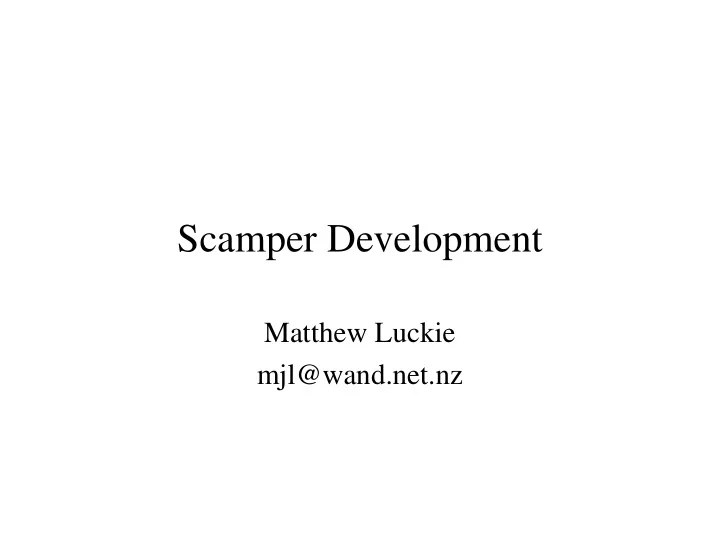

Scamper Development Matthew Luckie mjl@wand.net.nz
Last year’s scamper work • Inferring and Debugging PMTUD Failures – Paper at IMC 2005 • Datalink access – Bypass IP stack for writing some packets • Avoid IP stack fragmentation • Precise control over what appears on wire – Fixed bug in FreeBSD for writing to DLT_NULL BPF devices (6.0-RELEASE): PR kern/82157 – Did away with any code that manipulated the routing table
Last year’s scamper work • TCP Traceroute (IPv4) • Darryl Veitch’s TSC clock • File Format Work • SSL version of skdatad
Future Development • SSL version of skcollectd • Implement Doubletree Algorithm • BGP • Annotate data files with IP to DNS name at the time of capture • Rocketfuel • Pin-pointing Routing Changes
SSL version of skcollectd • Currently, skitter uses kerberos 4. • FreeBSD 5 onwards ships with kerberos 5. • Replace authentication / encryption with SSL which is more widely deployed and understood. – Some of this work has been done
The Doubletree Algorithm • Donnet / Raoult / Friedman / Crovella – (sigmetrics 2005) • Goal is to reduce the number of times an interface is visited during large-scale topology discovery • Intra-monitor redundancy – Many interfaces are visited repetitively from the same source • Inter-monitor redundancy – Many interfaces are visited repetitively from the distributed monitors
The Doubletree Algorithm • Avoid probing the destination and working backwards (as in Mercator) – a mesh of hosts probing the same address simultaneously might appear as a DDoS • Challenge then becomes determining where ( h ) to begin probing – Selecting an appropriate value of h – Current suggestion is to determine the hop distance where most new interfaces are discovered
BGP • Obtain routing table and updates by peering with a local router. • Annotate data files with BGP data at the time of capture • Re-probe path changes signaled by BGP update • Use AS path to guide Doubletree, discussed as future work in sigmetrics 2005 paper.
DNS • Annotate data files with IP to Name information • Not really a focus until Doubletree is used, since goal is to reduce network load • Leads to Rocketfuel…
Rocketfuel • Spring, Mahajan, Wetherall (SIGCOMM 2002) • Detailed ISP maps – They used 300 traceroute web servers… – … don’t have required skitter monitor deployment for this (20 or so monitors) but it is worth thinking about – there are other contributions to use • BGP to reduce probe count (RouteViews) • DNS data to determine purpose, location of routers • Alias resolution
Pin-pointing Routing Changes • Teixeria, Rexford. SIGCOMM NetTs 2004 • Straw-man proposal for inter-ISP cooperation through an “Omni” • Use BGP + Local AS policy + IGP • Not sure this fits with other proposed work, but it is something I’m interested in.
Feedback Invited
Recommend
More recommend